1962
First group exhibition in Paris: surveys, public debates. Trips: encounters with members of the Gruppo N (Padua), Gruppo T (Milan), and other artists doing research parallel to GRAV’s. Among these, Enzo Mari and Gerhard von Graevenitz and the critic Matko Meštrović. With all of them, the idea of the Nouvelle Tendance as an international movement began taking shape in encounters and various discussions. Exhibition Arte Programmata in Italy, in which GRAV took part.
Trip to New York for GRAV’s first exhibition in the United States. Personal text: “À propos de l'art-spectacle : spectateur-actif instabilité et programmation dans l'art visuel” (On Art as Spectacle: The Active Spectator, Instability and Programming in Visual Art). In the exhibit L’Art Latino-Américain in Paris, encounters with other Latin Americans.
Personal experiences with light and mobiles in a translucent cube and animation of a piece with light in movement projected on the walls, floor, and ceiling. Visualization of rays of light in movement. Experiences with raked light on a reflective cylinder.
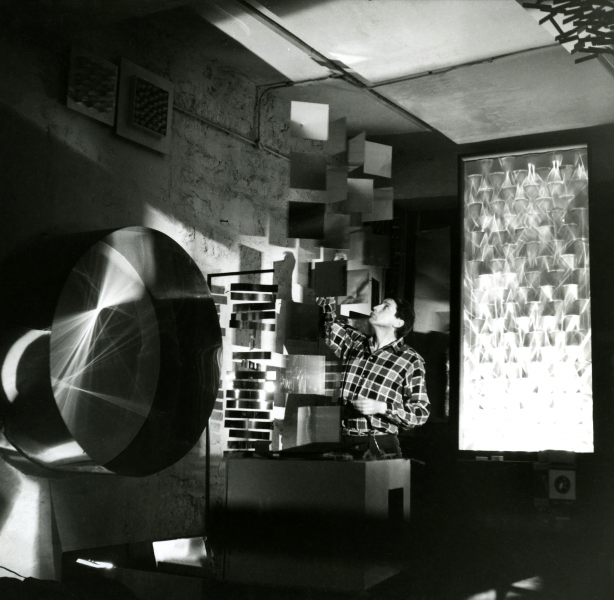 Julio Le Parc, atelier du GRAV, 1962
Julio Le Parc, atelier du GRAV, 1962 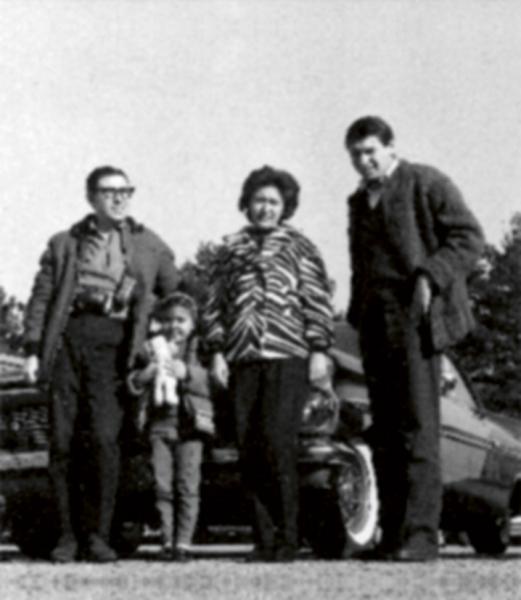 Avec la famille de sa soeur, New York, 1962
Avec la famille de sa soeur, New York, 1962 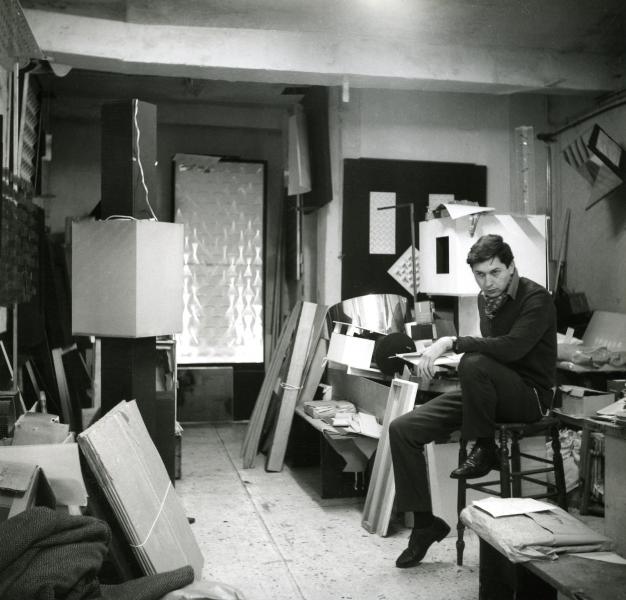 Julio Le Parc dans l'atelier du GRAV, Paris, 1962
Julio Le Parc dans l'atelier du GRAV, Paris, 1962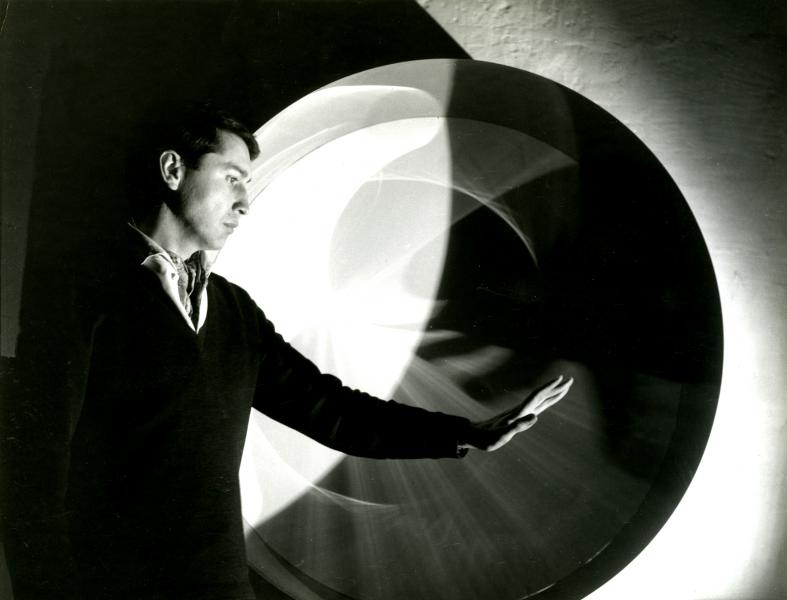 Julio Le Parc, continuel lumière cylindre, 1962
Julio Le Parc, continuel lumière cylindre, 1962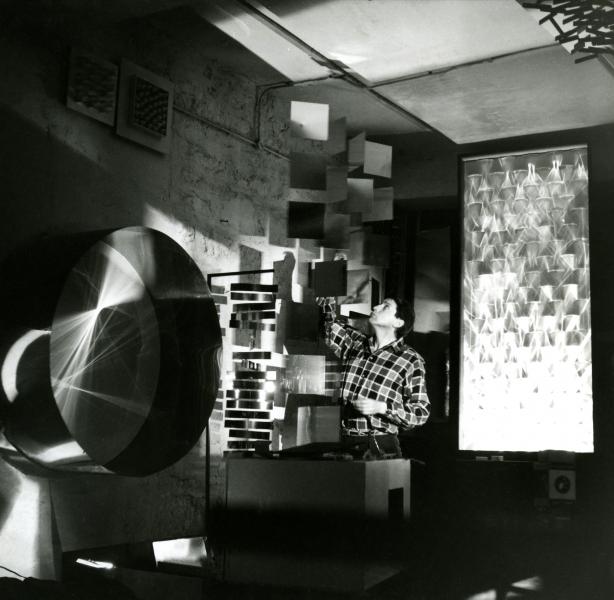 Julio Le Parc, atelier du GRAV, Paris, 1962
Julio Le Parc, atelier du GRAV, Paris, 19621961
Text by GRAV : “Propositions sur le mouvement” (Proposals on Movement) and, for the Paris Biennial, distribution of a flyer: “Assez de mystifications” (Enough Mystifications). Second presentation in the group workshop, encounters, panels, discussions, debates. Publication of the text “Propositions générales,” (General Propositions) signed by García Rossi, Le Parc, Morellet, Sobrino, Stein, Yvaral. Personal experiences on color-light in-depth with random changes.
1963
Several manifestations of GRAV under the title L'Instabilité (Instability). Group’s first L'Instabilité at the Paris Biennial. On behalf of the group, Le Parc took part in the International Congress of Art Critics in Rimini, where he presented the “Proposition pour un lieu d'activation” (Proposition for a Place of Activation). New text, under the title “Assez de mystifications” (Enough Mystifications).
On the occasion of the exhibit Nove Tendecije in Zagreb, Le Parc traveled to Zagreb and encountered most of the exhibitors, discussions, and organization of the Nouvelle Tendance as an international movement.
Gabriel, his second son, was born.
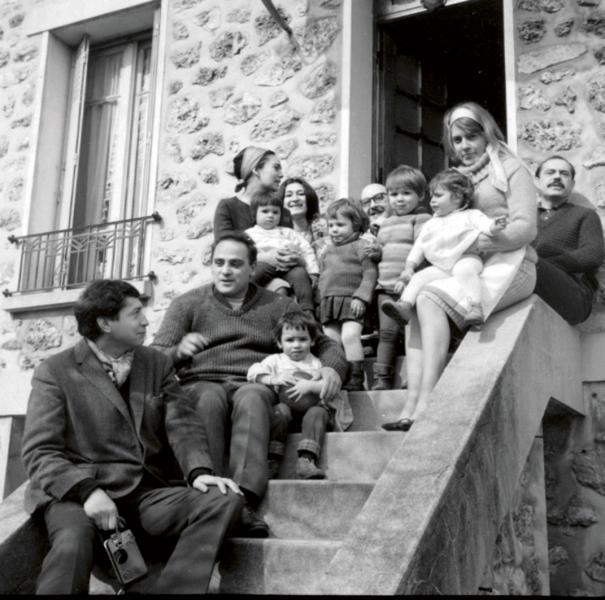 Avec les familles Demarco, Sobrino, Le Parc et Horacio. Antony, 1963
Avec les familles Demarco, Sobrino, Le Parc et Horacio. Antony, 1963 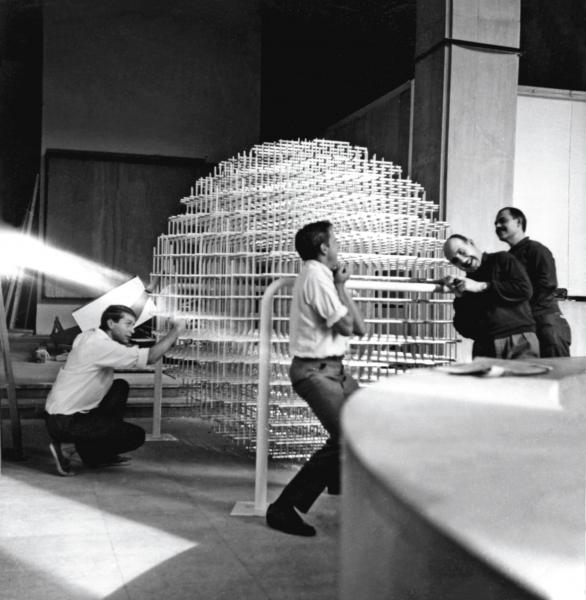 Julio Le Parc, François Morellet, Francisco Sobrino, Biennale de Paris
Julio Le Parc, François Morellet, Francisco Sobrino, Biennale de Paris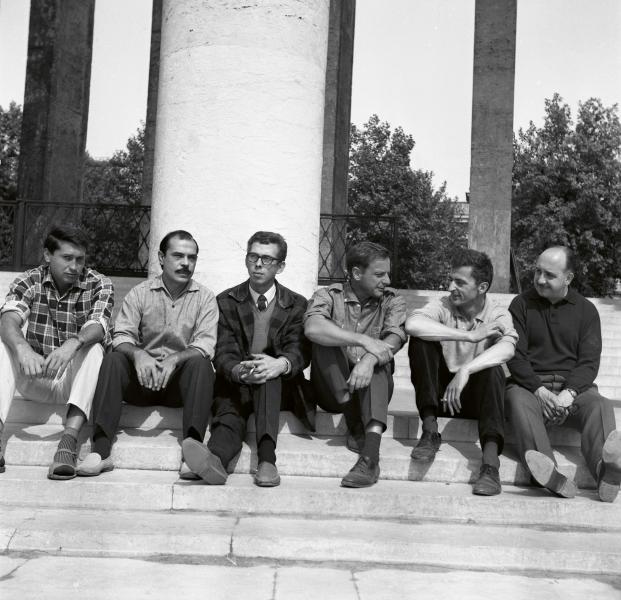 Le Parc, Sobrino, Morellet, Stein, Garcia-Rossi, Paris 1963
Le Parc, Sobrino, Morellet, Stein, Garcia-Rossi, Paris 19631964
Le Parc organized encounters of artists of the Nouvelle Tendance with hopes of a large demonstration in Paris, in which Le Parc, along with Morellet and Stein, created a labyrinth. Proposed to GRAV to hold Une journée dans la rue (A Day in the Street). Traveled to Argentina and Brazil for exhibitions of GRAV’s Instability : encounters, debates, discussions, etc.
Le Parc developed ideas for labyrinths, passages, elements to be manipulated, reliefs with curved reflectors.
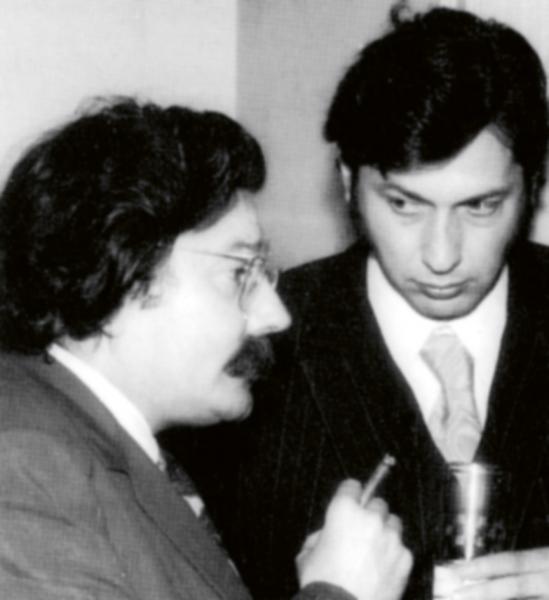 Avec Pierre Restany, Buenos Aires, 1964
Avec Pierre Restany, Buenos Aires, 1964 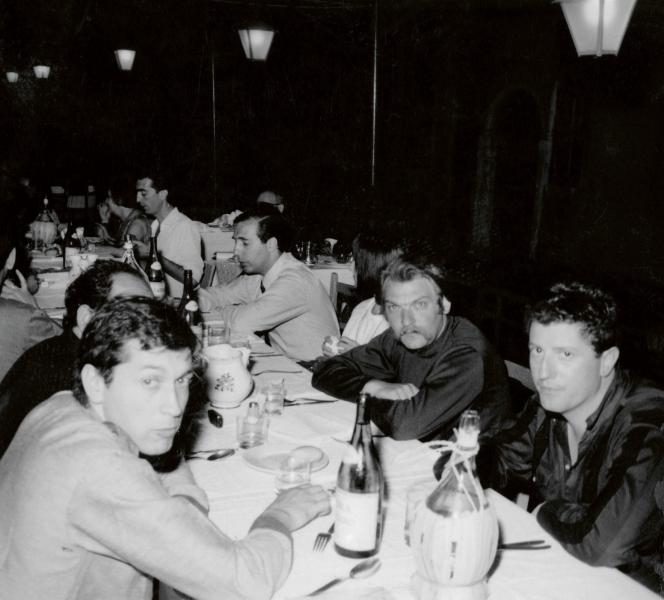 Avec Brook, Segui, Maccio..., Venise, 1964
Avec Brook, Segui, Maccio..., Venise, 1964 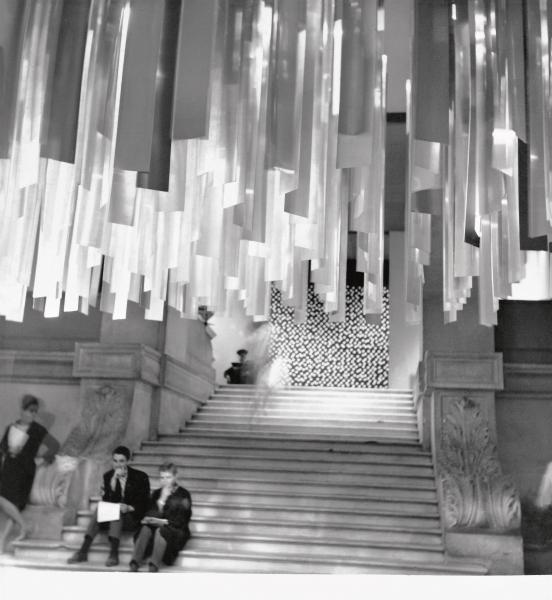 Julio Le Parc, Continuel mobile, exposition "Nouvelle tendance", musée des Arts Décoratifs, Paris.
Julio Le Parc, Continuel mobile, exposition "Nouvelle tendance", musée des Arts Décoratifs, Paris.1965
With the group, created third L'Instabilité in New York. Published text “Stop-Art.”
At the Paris Biennial, GRAV created a gallery of games in which the viewer was considered even more fully as an active, determining element of the proposed situations.
Le Parc developed themes, such as games, mirrors in movement, elements for galleries of games, groups of surprise movements, shoes for walking differently, eyeglasses for seeing in other ways, etc.
Yamil, his third son, was born.
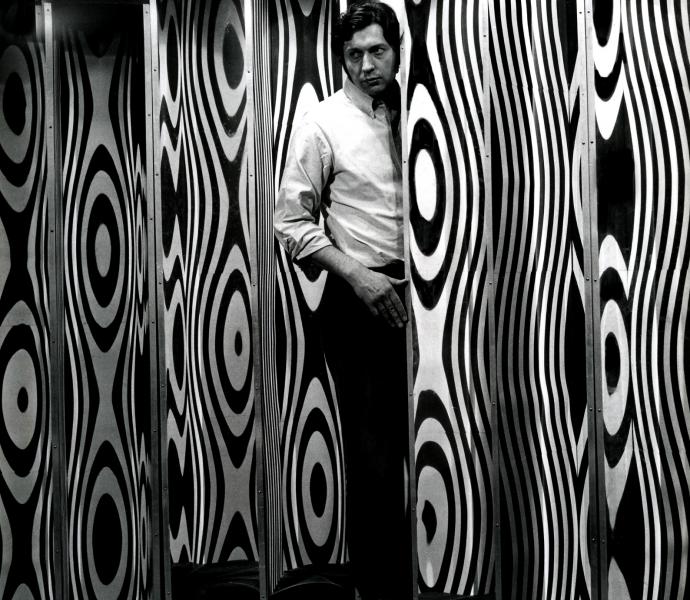 Cercles virtuels par déplacement du spectateur, 1965
Cercles virtuels par déplacement du spectateur, 1965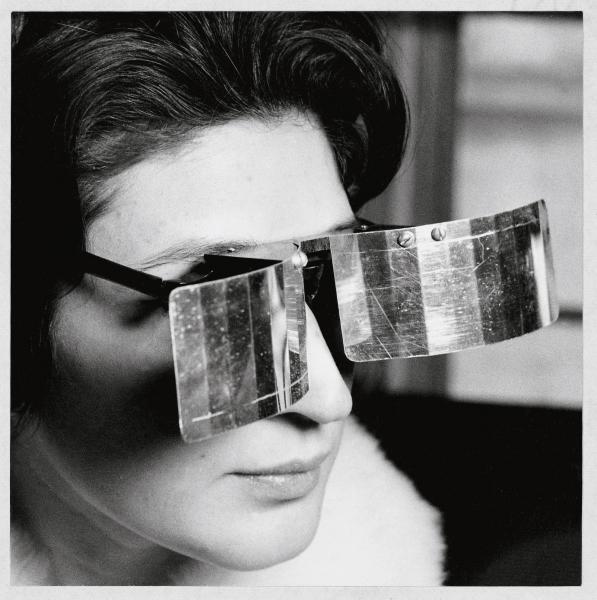 Martha Le Parc avec Lunettes pour une vision autre, 1965
Martha Le Parc avec Lunettes pour une vision autre, 1965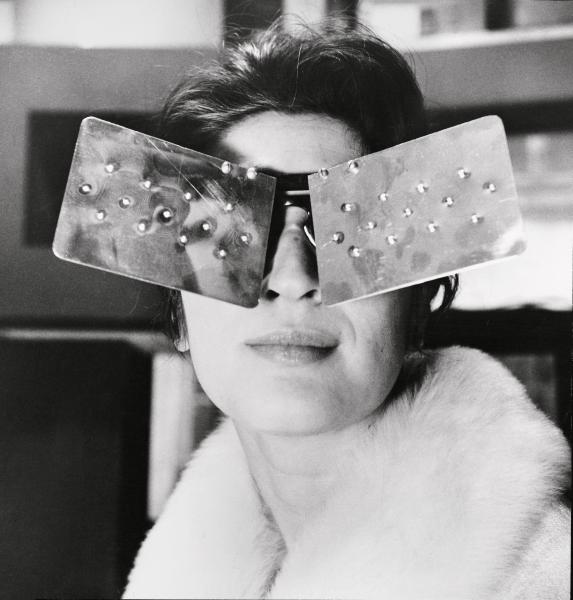 Martha Le Parc avec Lunettes pour une vision autre, 1965
Martha Le Parc avec Lunettes pour une vision autre, 19651966
First solo exhibit, at the Howard Wise Gallery, New York.
With GRAV, Le Parc created an experience in Paris titled Une journée dans la rue. The experience began at eight in the morning and ended at midnight, despite the intervention of the police. Planned in 1964, the experience comprised a presentation of several different elements that, grouped together or not, provoked different situations every two hours and in various places in the city. It was accompanied by a flyer with a text by GRAV, a map with the day’s program, and a survey.
Solo gallery at the Venice Biennale, where Le Parc was awarded the Grand Prize for Painting. He was interviewed in the magazine Robho. GRAV text on the subject of multiples.
First solo show in Paris, at the Galerie Denise René, Rive Droite and Rive Gauche: a creation and presentation of Multiples. Group presentation at the Kunst Licht Kunst exhibit in Eindhoven : a labyrinth in which light was used as an invitation to the viewer to participate in the installation.
Le Parc developed groups with surprise movements, explored pulsing light, mirror series, elements for Une journée dans la rue, and Multiples.
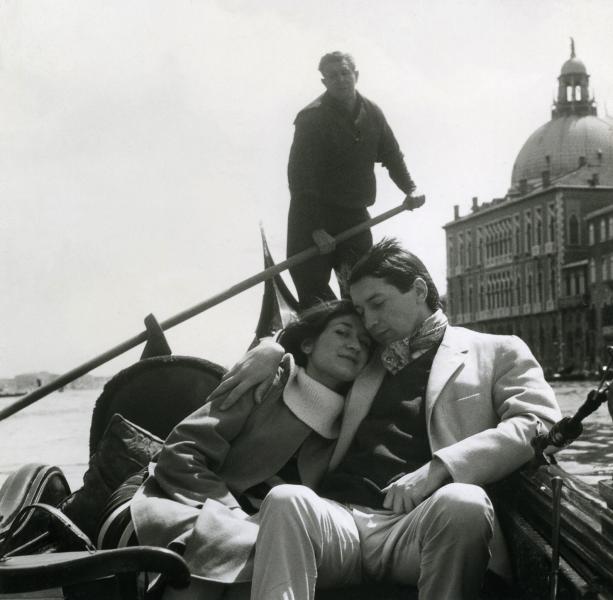 Julio et Martha, Venise 1966
Julio et Martha, Venise 1966 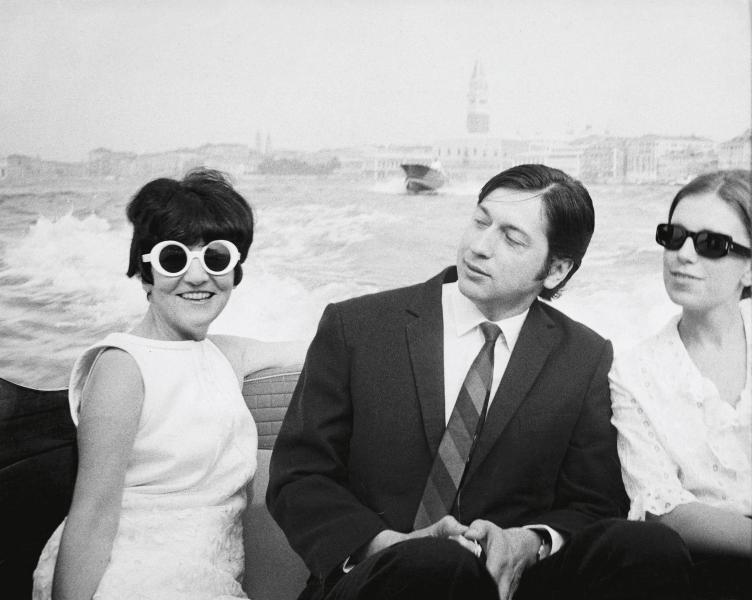 Julio et Denise René, motoscafo à Venise 1966
Julio et Denise René, motoscafo à Venise 1966 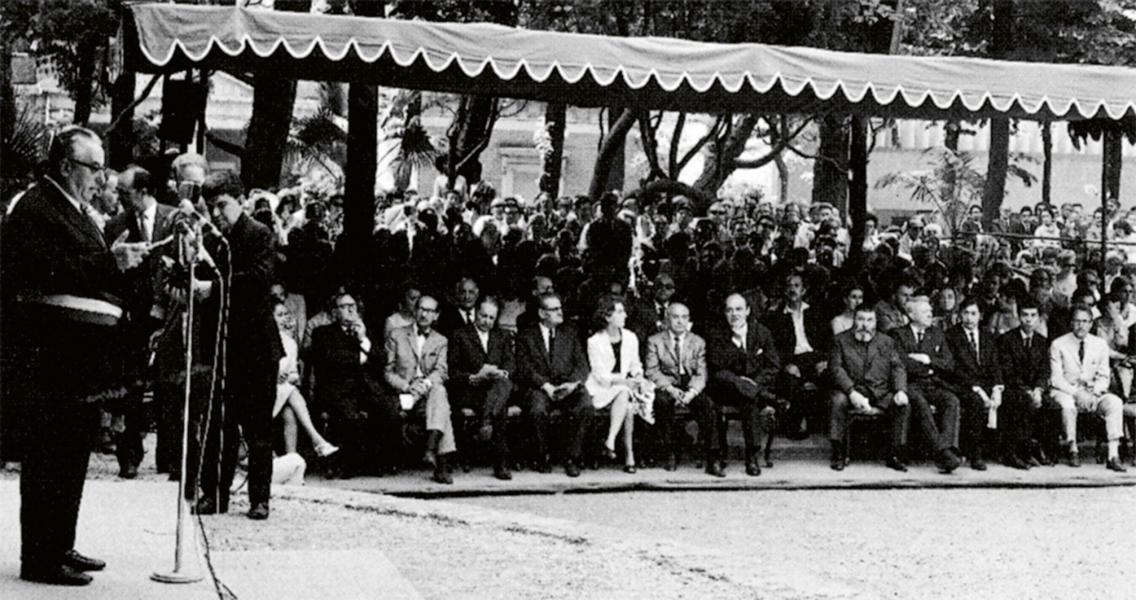 Cérémonie prix Biennale de Venise, 1966
Cérémonie prix Biennale de Venise, 1966  Cérémonie de la Biennale de Venise, Venise, 1966
Cérémonie de la Biennale de Venise, Venise, 1966  Vasarely, Denis René, Le Parc, Paris, 1966
Vasarely, Denis René, Le Parc, Paris, 1966 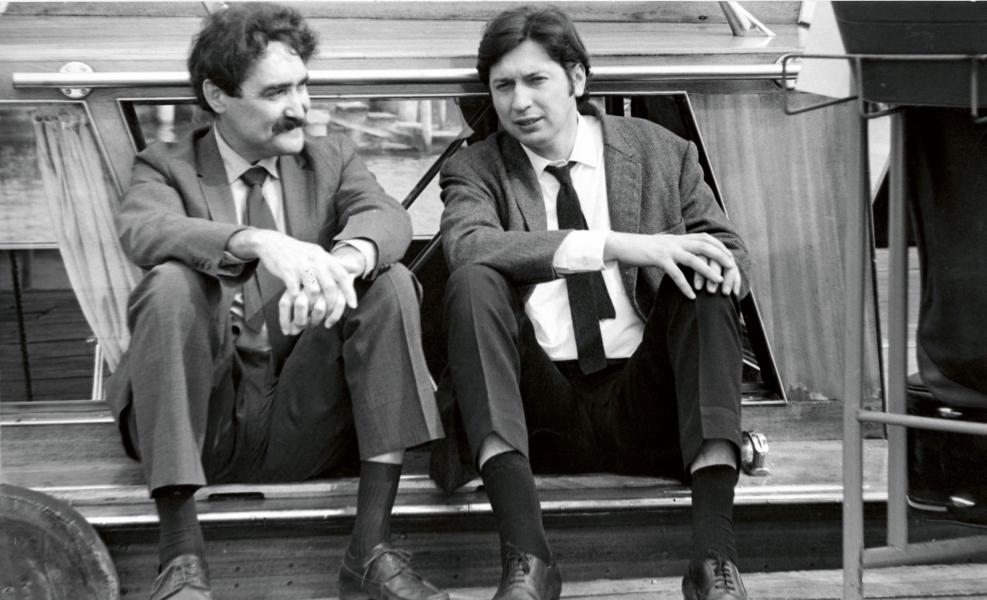 Avec Soto, Venise, 1966
Avec Soto, Venise, 1966 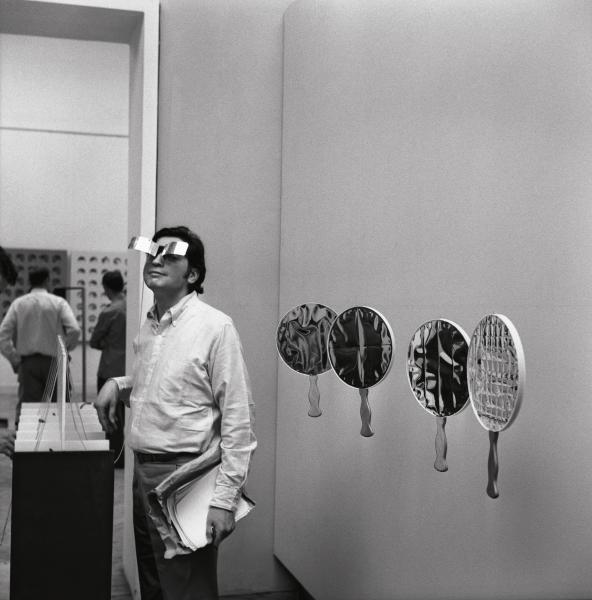 Exhibition in Venice, 1966.
Exhibition in Venice, 1966.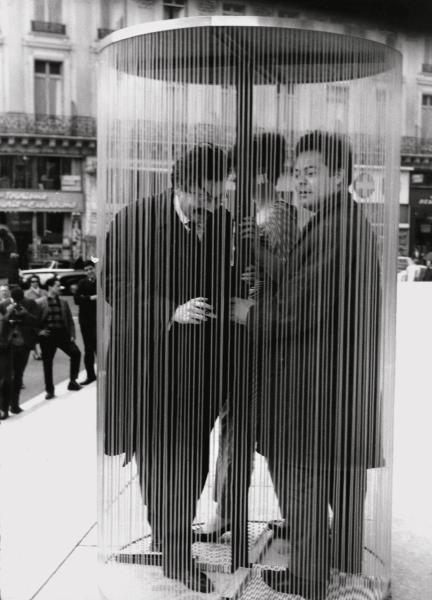 Une journée dans la rue, Pierre Restany et Otto Hahn dans la cage
Une journée dans la rue, Pierre Restany et Otto Hahn dans la cage1967
Second trip to Latin America, for several solo exhibitions. First retrospective, at the Instituto Torcuato di Tella, Buenos Aires. Encounters, debates, exchanges of ideas, discussions, statements, interviews, etc.
Creation of Anti-Voiture (Anti-Car). Creation, with GRAV, of a Parcours à volume variable (Variable Volume Tour) in Paris.
Personally, developed themes with pulsing light, environmentalization, forms in contortion, transparent wall with reflective plaques, etc.
Work on the text “Guérilla culturelle?” (Cultural Guerrilla?). Le Parc was made a Chevalier de l’Ordre des Arts et des Lettres by André Malraux, French Minister of Culture.
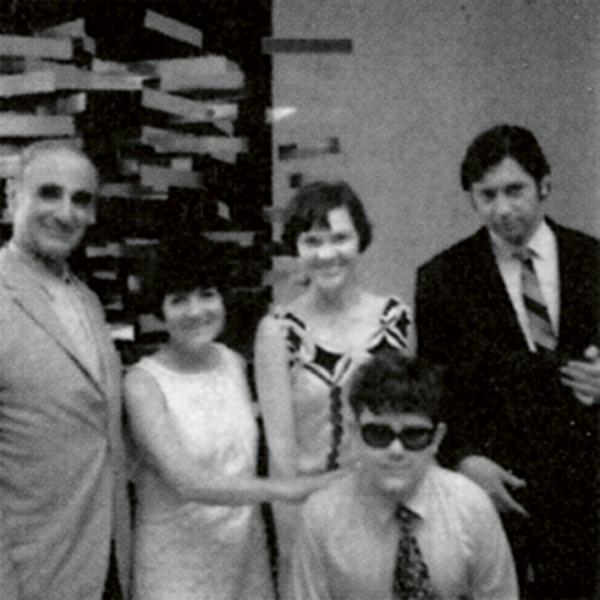 Avec Denise René et la famille Howard Wise, New York, 1967
Avec Denise René et la famille Howard Wise, New York, 1967 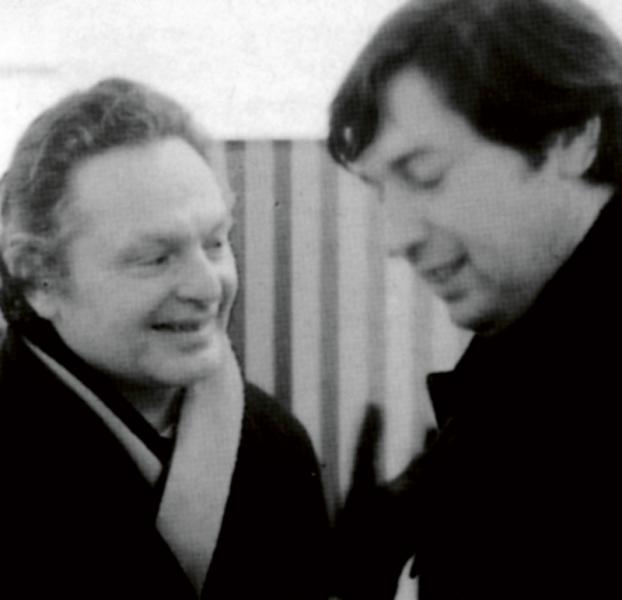 Avec Frank Popper, 1967
Avec Frank Popper, 1967  Avec Yamil, Quilmes, 1967
Avec Yamil, Quilmes, 1967 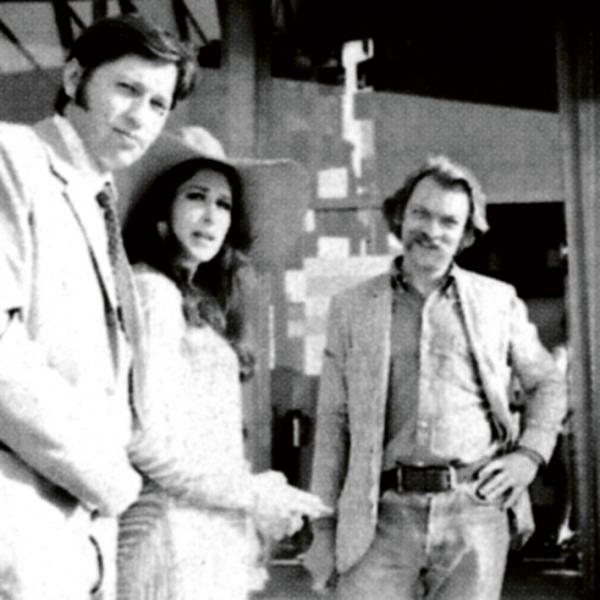 Avec Martha et Antonio Segui, Saint-Laurent-du-Pont, 1967
Avec Martha et Antonio Segui, Saint-Laurent-du-Pont, 1967 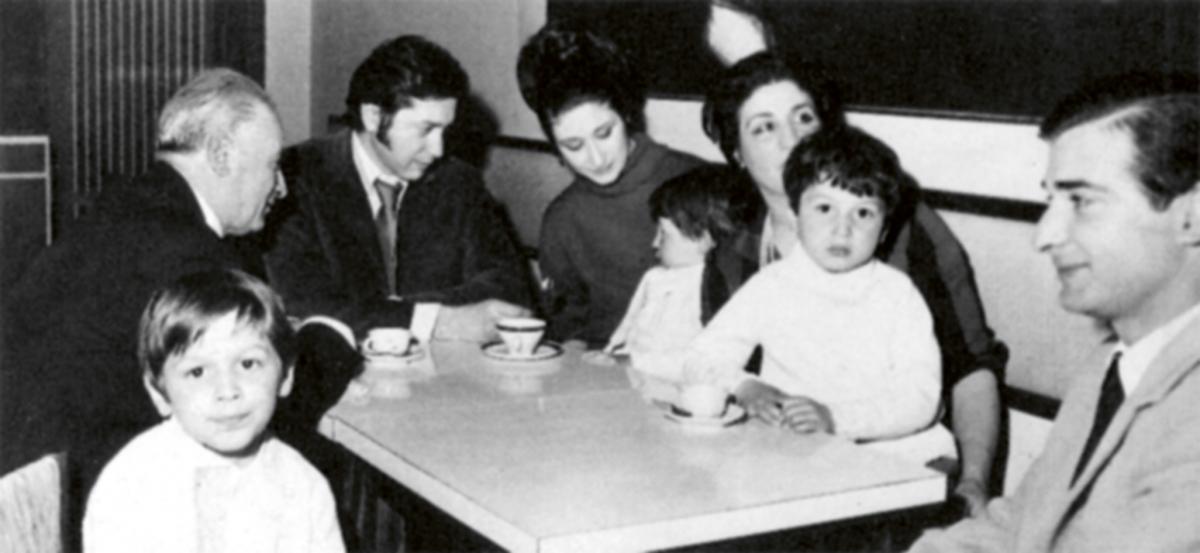 Avec Martha, les enfants et la famille de Martha, Buenos Aires, 1967
Avec Martha, les enfants et la famille de Martha, Buenos Aires, 1967 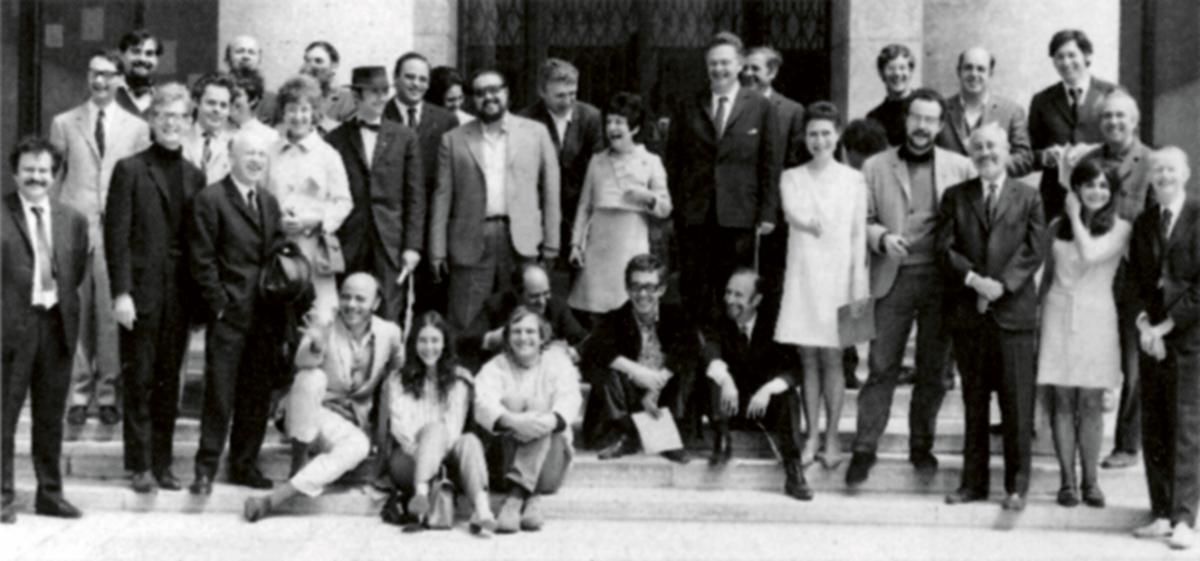 Participants de l'exposition "Lumière et mouvement", Paris 1967
Participants de l'exposition "Lumière et mouvement", Paris 1967 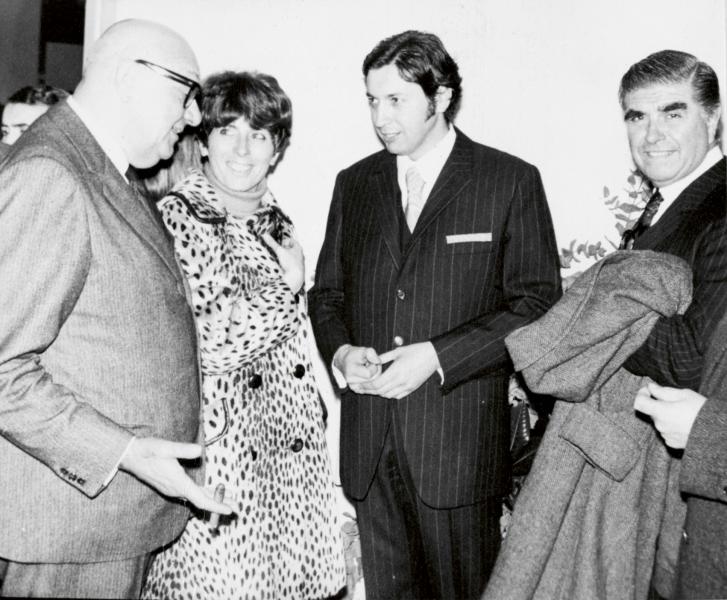 Avec Romero Brest et Ignacio Pirovano, Buenos Aires, Insituto di Tella 1967
Avec Romero Brest et Ignacio Pirovano, Buenos Aires, Insituto di Tella 1967 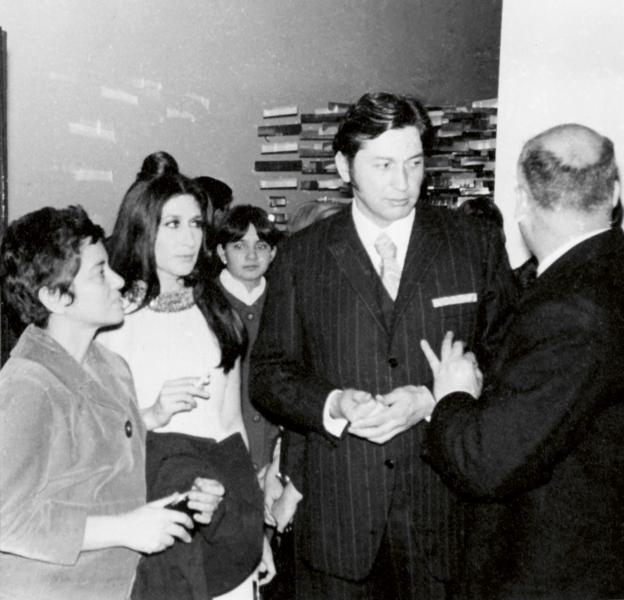 Avec Laura Marques, Martha et Tito Perrusi, Buenos Aires, Instituto Di Tella 1967
Avec Laura Marques, Martha et Tito Perrusi, Buenos Aires, Instituto Di Tella 1967 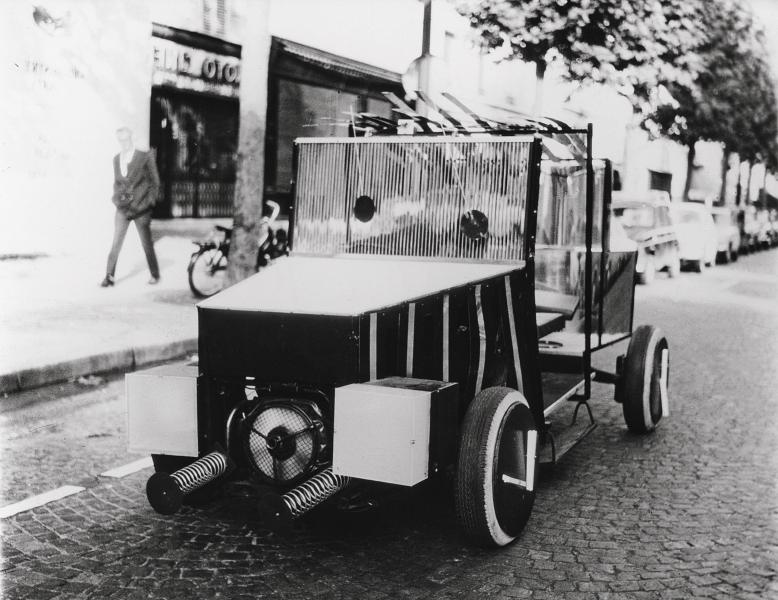 Anti-voiture, Paris
Anti-voiture, Paris Kunsthalle Nuremberg, Yvaral, Sobrino, Garcia Rossi, Morellet, Le Parc, Stein
Kunsthalle Nuremberg, Yvaral, Sobrino, Garcia Rossi, Morellet, Le Parc, Stein1968
Publication of the text “Guérilla culturelle?” in Robho.
A large GRAV exhibition, titled In Search of a New Viewer, in Dortmund, Germany, with a large games gallery and an exit to the street with elements of play, plus the Anti-Voiture. With the group, creation of collective works, one titled Variations sur l'escalade (Variations on the Climb) in Buffalo, Œuvre pénétrable (Penetrable) in St. Paul de Vence, and another in Grenoble on a revolving stage, taking advantage of the mobile elements and the movement of the stage. In these collective works, the viewer was always the essential element, and it was the viewer’s participation that gave meaning to the work. The group completed a book project on its activities, reflections, texts, creations, etc.
May 1968 events in France. General disgust, rejection, revulsion. Atelier Populaire for the masses. With others, Le Parc and Demarco were expelled from France; Le Parc traveled through several European countries, and with Enzo Mari sent a telegram to Documenta withdrawing from participation. Five months later, the expulsion was lifted thanks to numerous requests and actions from the world of culture, and Le Parc returned to Paris. GRAV dissolved. Analytical texts; text “Démystifier l'art” (Demystify Art). Analysis and discussion about the behavior of the artist.
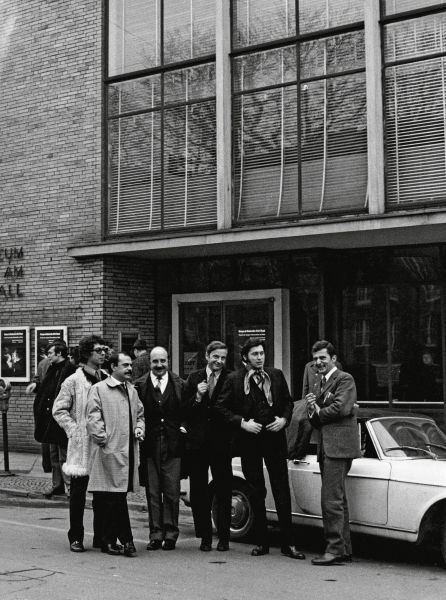 Membres du GRAV devant le Museum am Ostwall, 1968
Membres du GRAV devant le Museum am Ostwall, 1968 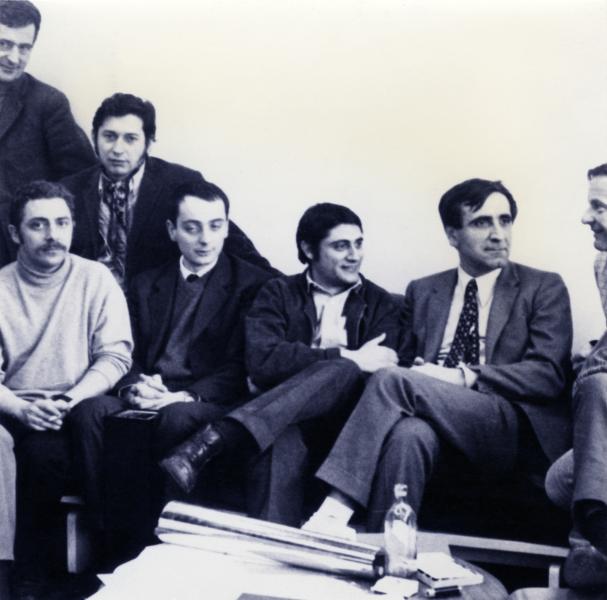 Stein, Boriani, Le Parc, Massoroni, Colombo, Mari, Morellet, Grenoble 1968
Stein, Boriani, Le Parc, Massoroni, Colombo, Mari, Morellet, Grenoble 1968 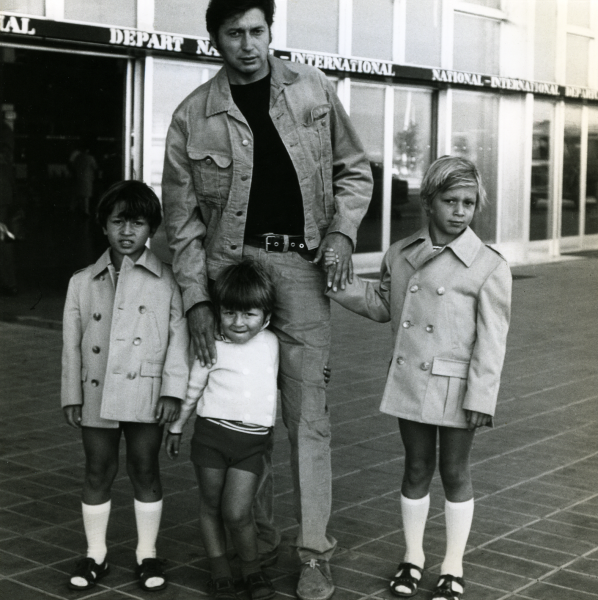 Avec Gabriel, Yamil et Juancito, Barcelone, 1968
Avec Gabriel, Yamil et Juancito, Barcelone, 1968 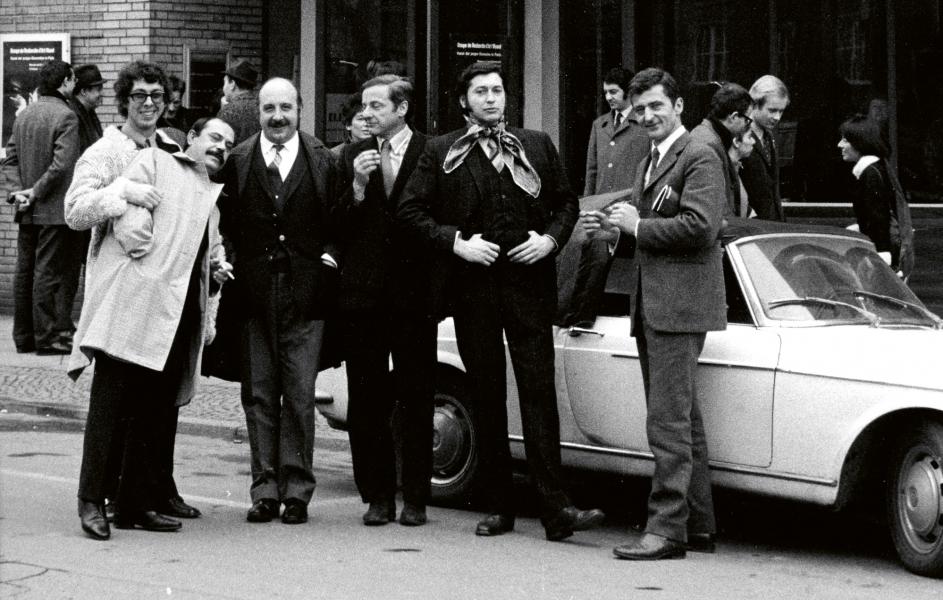 GRAV, Dortmund, 1968
GRAV, Dortmund, 1968 1969
A year of transition, collective reflections, unrealized collective projects. Preparation for Amerique latine non officielle (Unofficial Latin America). Boycott of the São Paulo Biennial. Public rallies, international campaign to mobilize artists, statements, etc., in the cultural media.
First game-survey: “Overturn the Myths.” Creation of cells (artworks) in which light, vibrating and in movement, surrounded the viewer. Le Parc returned to his 1959 experiences in color, systematizing and developing them.
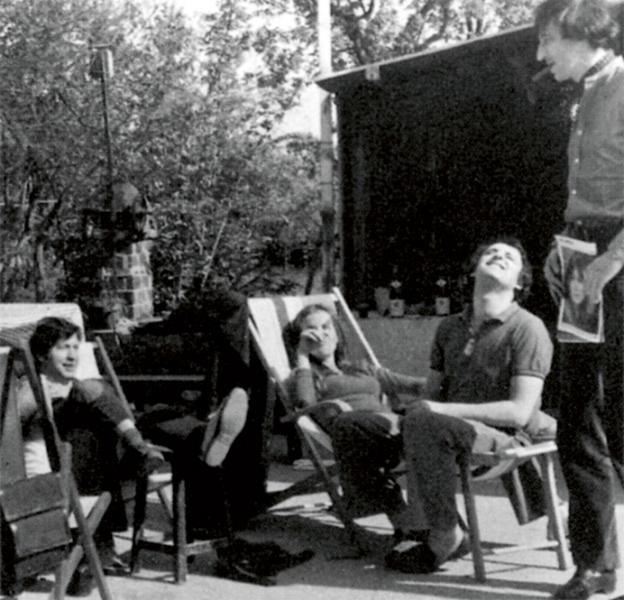 Avec Fromanger et Rougemont, Antony 1969
Avec Fromanger et Rougemont, Antony 1969 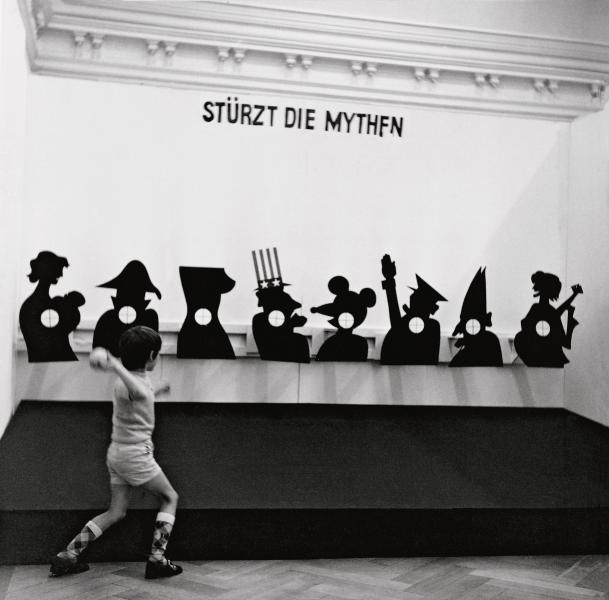 Julio Le Parc, Faites tomber les mythes, 1969
Julio Le Parc, Faites tomber les mythes, 1969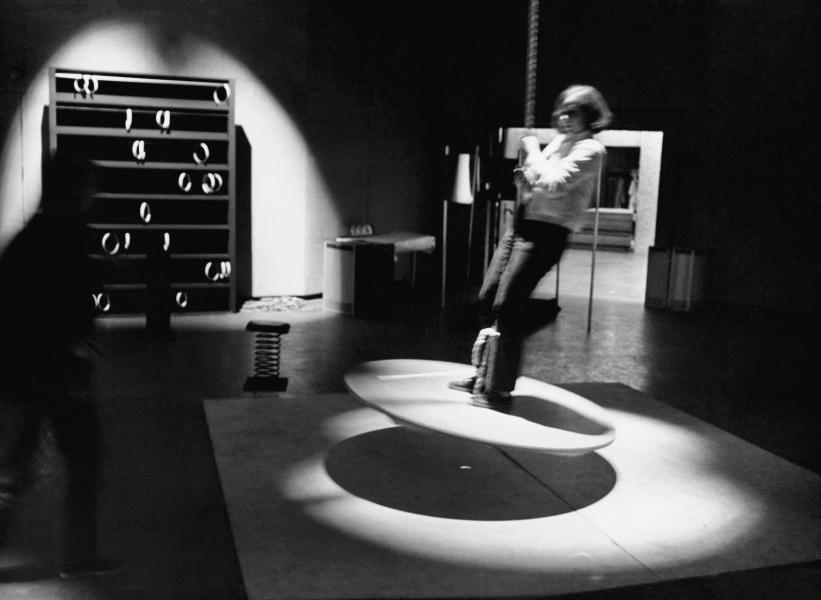 Salle de jeux, rétrospective, Henie-Onstad
Salle de jeux, rétrospective, Henie-Onstad